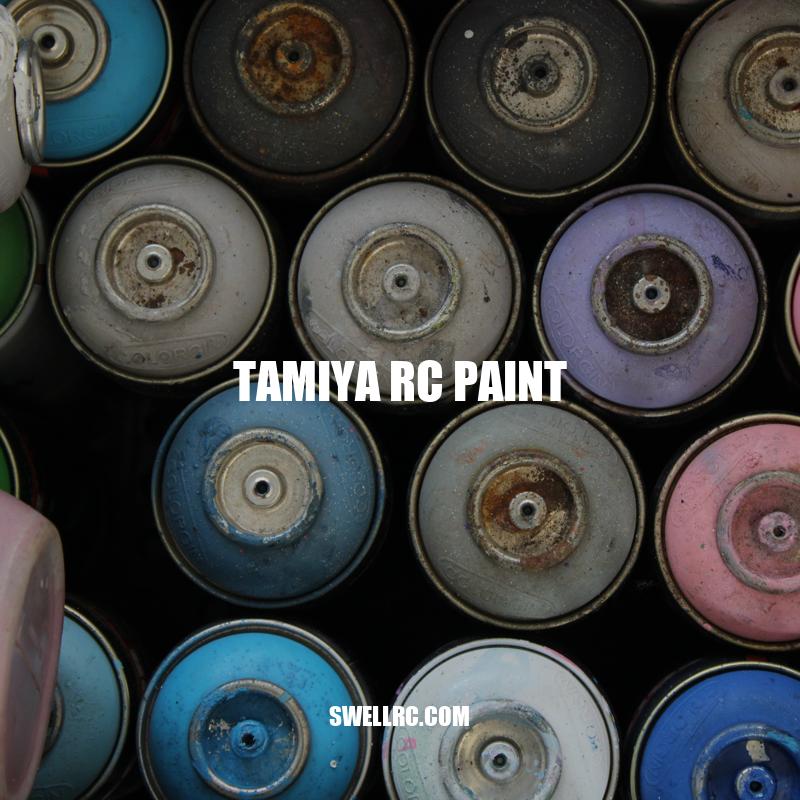Tamiya RC Paint: The Ultimate Guide for a Perfect Finish
Tamiya RC paint is a high-quality paint specifically designed for RC models. Tamiya is a popular brand in the RC hobby world, known for its attention to detail and commitment to quality. RC models are often used in competitions or driven through challenging terrain, so it’s important to use a paint that can withstand wear and tear. Tamiya RC paint fills this need with its unique formula that provides a hard, durable finish that lasts. Unlike other brands, Tamiya offers a wide range of colors and finishes, including metallic, gloss, and flat options. Choosing the right Tamiya RC paint for your model is important for achieving a professional-looking finish and matching the desired color scheme. In this article, we’ll cover everything you need to know about Tamiya RC paint, from what it is and its unique properties to tips for choosing the right color and using the paint effectively.
What is Tamiya RC paint?
Tamiya RC paint is a specially formulated paint designed for RC models that provides a durable, hard finish that lasts. Here’s what you need to know about Tamiya RC paint:
- Tamiya is a well-known brand in the RC hobby world
- Tamiya RC paint is available in a variety of finishes ranging from metallic to gloss and matte
- Unlike other brands, Tamiya offers a wide variety of colors, including custom color mixing options
- Tamiya RC paint is easy to use and provides excellent coverage with minimal coats
- It is compatible with a range of materials, including plastics and metals
- Tamiya RC paint dries quickly, which makes detailing a breeze
- You can find Tamiya RC paint at hobby stores or online retailers
Whether you’re a beginner or seasoned RC hobbyist, Tamiya RC paint is an excellent choice for achieving a professional and long-lasting finish on your RC models. In the next section, we’ll go over some essential tips for choosing the right Tamiya RC paint for your model.
How to paint Tamiya RC?
To paint Tamiya RC, first, you need to clean the surface with soap and water to remove any dirt or oil. Then sand the surface gently with a high-grit sandpaper to create a rough surface for the paint to adhere. After this, you can apply a primer coat to improve paint adhesion and coverage. Once the primer coat is dry, you can apply the desired paint color using an airbrush or spray can. Tamiya offers a range of paints and primers specifically designed for RC models. Also, you can find detailed instructions and tips on their website.
Choosing the right Tamiya RC paint
When it comes to selecting the right Tamiya RC paint, there are a few things to keep in mind. Here are some tips to consider:
- Consider the material of your model when selecting a Tamiya RC paint
- If your model has a glossy finish, choose Tamiya RC paint with a glossy finish as well
- If you’re unsure of which color to choose, start with a base color and add layers for a custom hue
- For metallic finishes, choose a metallic Tamiya RC paint with a clear coat for added shine
- Take note of the recommended drying time and number of coats required for the Tamiya RC paint you choose
The Tamiya RC paint line offers a wide range of colors and finishes to choose from. Here’s a table showing some of the most popular finishes and their corresponding color codes:
| Finish | Color Code |
|---|---|
| Glossy | X-1 – X-35 |
| Semi-Glossy | XF-1 – XF-86 |
| Matte | Flat Base – XF-88 |
| Metallic | TS-1 – TS-98 |
With these tips in mind, you can select the right Tamiya RC paint for your model, which will provide a high-quality and long-lasting finish. In the next section, we’ll go over some essential tips for using Tamiya RC paint.
What paint to use on Tamiya RC cars?
For painting unpainted Tamiya RC car shells, you should use TAMIYA PS polycarbonate spray paints that come in various color shades. These paints are specially developed to give your Tamiya RC car model a personalized touch. For more information, you can visit Tamiya’s official website.
Using Tamiya RC paint
To achieve the best results when using Tamiya RC paint, preparation and technique are key. Here are some essential tips for using Tamiya RC paint on your model:
- Clean the surface of your model before beginning the painting process
- Prime your model with Tamiya Fine Surface Primer before painting to ensure the paint adheres properly
- Shake the Tamiya RC paint well before use and use a stirrer to ensure an even consistency
- Apply thin coats of paint, allowing each coat to dry completely before applying the next
- Use a brush or airbrush to apply the Tamiya RC paint, depending on the size and intricacy of your model
- Clean your brushes or airbrush thoroughly after use, as Tamiya RC paint is alcohol-based and can be difficult to remove once dry
By following these tips, you can ensure a smooth and even finish to your model. It’s also important to work in a well-ventilated area and take breaks as needed to avoid inhaling fumes from the paint.
There are a few techniques you can use to add depth and detail to your finished model as well. One technique is to use masking tape to create sharp lines and edges between different colors or finishes of paint. Dry brushing is another technique that involves using a small amount of paint on a dry brush to highlight details and textures on your model.
Whether you’re a beginner or experienced modeler, using Tamiya RC paint can help elevate your RC model to the next level. In the next section, we’ll go over some tips for maintaining your Tamiya RC paint over time.
How long should I let Tamiya paint dry?
Tamiya recommends letting their paint dry for 24 hours before handling or applying additional coats.
Tips for maintaining Tamiya RC paint
After investing time and effort in painting your RC model with Tamiya RC paint, you want to make sure the paint job lasts and looks great over time. Here are some tips for maintaining your Tamiya RC paint:
- Handle your model carefully to avoid scratching or chipping the paint
- Store your model in a dust-free environment to prevent buildup on the paint surface
- Consider using a clear coat or protective film to add an extra layer of protection to your paint job
- Use a soft-bristled brush or microfiber cloth to gently clean any dust or debris from the painted surface
- Avoid using harsh chemicals or abrasive cleaners on the paint, as they can damage the finish
- If you do find scratches or wear over time, consider using Tamiya Polishing Compound to gently restore the finish of the paint without damaging it further
By taking these steps, you can ensure your Tamiya RC paint job looks great for years to come. It’s important to note that Tamiya RC paint should be used and stored away from heat sources, flames, and direct sunlight, as exposure to high heat or UV radiation can cause the paint to discolor or deteriorate.
In addition to the products mentioned in this article, there are numerous resources available online for RC modelers, from forums and blogs to online retailers offering a wide range of Tamiya RC paint options. With some experimentation and practice, using Tamiya RC paint can help elevate your RC models to the next level.
How long should I wait between coats of Tamiya spray paint?
ALWAYS REMEMBER TO APPLY LIGHT TOP COATS, LET dry and cure for 24 hours before applying further coats, or a wet coat if necessary. This will ensure that each coat of Tamiya spray paint dries fully and will bond properly to the layer underneath. It is essential for achieving a smooth and even finish. For more information, visit the Tamiya website or consult the product label for specific recommendations.
Conclusion
Tamiya RC paint is a high-quality, versatile choice for anyone looking to add some style and flair to their RC models. With a wide range of colors and finishes, it’s easy to find the perfect Tamiya paint for your project, whether you’re looking to match a specific color scheme or create a custom design. By following the tips in this article, you can ensure that your Tamiya RC paint job looks great and lasts for years to come.
One of the best things about Tamiya RC paint is its ease of use and compatibility with a variety of RC model types and materials. Whether you’re a hobbyist or a more experienced RC modeler, using Tamiya RC paint can help enhance the look and feel of your models. With a little practice and experimentation, you can achieve professional-quality results that are sure to impress.
Overall, Tamiya RC paint is a great solution for anyone looking to take their RC models to the next level. By following the tips and techniques outlined in this article, and exploring the range of options available from Tamiya and other brands, you can create stunning RC models that truly stand out from the crowd.



